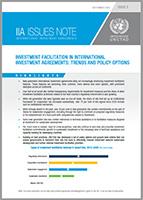
IIA Issues Note, No. 3, 2023
- New-generation international investment agreements (IIAs) are increasingly embracing investment facilitation features. These features are becoming more common, more diverse and more specific, with prominent examples across all continents.
- Over half of all recent IIAs contain transparency requirements for investment measures and the share of other investment facilitation provisions related to the host country’s regulatory environment is also growing.
- While old-generation IIAs were typically seen as one-off deals, the share of IIAs that set up an institutional framework for cooperation has increased substantially. Over 70 per cent of IIAs signed since 2020 include such an institutional mechanism.
- While virtually absent in the past, over 30 per cent of new generation IIAs contain commitments on the part of States for stakeholder engagement, including through the right to comment on proposed regulatory measures or the establishment of a focal point with competencies related to investment.
- Some new-generation IIAs also contain references to technical assistance or to facilitation measures targeted at investment for sustainable development.
- Yet, much more is needed. Save for a few exceptions, new IIAs continue to lack clear and proactive investment facilitation commitments specific to sustainable investment or the necessary level of technical assistance and capacity-building for developing countries.
- Building on best practices, UNCTAD has developed a set of policy options and ground-level actions that can enable governments to transform their IIAs into tools to effectively channel investment towards sustainable development and further national investment facilitation priorities.
Investment Facilitation in International Investment Agreements: Trends and Policy Options - IIA Issues Note, No. 3, 2023 (UNCTAD/DIAE/PCB/INF/2023/5)
25 Sep 2023


